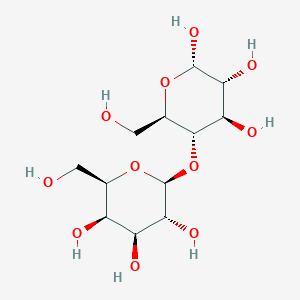| General Information of MET (ID: META00192) |
| Name |
Alpha-Lactose
|
| Synonyms |
Click to Show/Hide Synonyms of This Metabolite
(+)-Lactose; 1-beta-D-Galactopyranosyl-4-alpha-D-glucopyranose; 1-beta-delta-Galactopyranosyl-4-alpha-delta-glucopyranose; 4-O-Hexopyranosylhexose; 4-O-beta-D-Galactopyranosyl-alpha-D-glucopyranose; Aletobiose; Anhydrous lactose; Dilactose; Fast-flo lactose; Flowlac 100; GLC-(4-1)Gal; Galactinum; Granulac 140m; Lactin; Lactin (carbohydrate); Lactobiose; Lactohale 300; Lactose; Lactose anhydride; Lactose fast-flo; Lactose, anhydrous; Milk sugar; Osmolactan; Pharmatosa DCL 21; Pharmatose 21; Pharmatose 325m; Pharmatose DCL 15; Prismalac; Respitose ML 003; Respitose SV 003; Saccharum lactin; Sachelac; Sorbalac 400; Sorbolac 400; Spherolac; Super-tab; Tablettose; Tablettose 70; Tablettose 80; Zeparox ep; beta-D-Galp-(1->4)-alpha-D-GLCP
|
| Source |
Endogenous;Escherichia Coli Metabolite;Food
|
| Structure Type |
Carbohydrates and carbohydrate conjugates (Click to Show/Hide the Complete Structure Type Hierarchy)
Organic oxygen compounds
Organooxygen compounds
Carbohydrates and carbohydrate conjugates
|
| PubChem CID |
|
| HMDB ID |
|
| Formula |
C12H22O11
|
| Structure |
<iframe style="width: 300px; height: 300px;" frameborder="0" src="https://embed.molview.org/v1/?mode=balls&cid=84571"></iframe>
|
 |
|
3D MOL
|
2D MOL
|
|
Click to Show/Hide the Molecular/Functional Data (External Links/Property/Function) of This Metabolite
|
| KEGG ID |
|
| ChEBI ID |
|
| FooDB ID |
|
| ChemSpider ID |
|
| METLIN ID |
|
| Physicochemical Properties |
Molecular Weight |
342.3 |
Topological Polar Surface Area |
190 |
| XlogP |
-4.7 |
Complexity |
382 |
| Heavy Atom Count |
23 |
Rotatable Bond Count |
4 |
| Hydrogen Bond Donor Count |
8 |
Hydrogen Bond Acceptor Count |
11 |
| Function |
alpha-Lactose is the major sugar present in milk and the main source of energy supplied to the newborn mammalian in its mother's milk. Lactose is also an important osmotic regulator of lactation. It is digested by the intestinal lactase (EC 3.2.1.108), an enzyme expressed in newborns. Its activity declines following weaning. As a result, adult mammals are normally lactose-intolerant and more than 75% of the human adult population suffers from lactase deficiency. Lactase deficiency is present in up to 80 percent of blacks and Latinos, and up to 100 percent of American Indians and Asians. Persons with lactose intolerance are unable to digest significant amounts of lactose. Common symptoms include abdominal pain and bloating, excessive flatus, and watery stool following the ingestion of foods containing lactose. A sizable number of adults believe they are lactose intolerant but do not actually have impaired lactose digestion, and some persons with lactase deficiency can tolerate moderate amounts of ingested lactose. A diagnosis of lactose intolerance can usually be made with a careful history supported by dietary manipulation. If necessary, diagnosis can be confirmed by using a breath hydrogen or lactose tolerance test. These mostly uncomfortable symptoms of lactose maldigestion are blamed for a variably dairy consumption. There is, however, emerging evidence that certain lactic acid-producing bacteria, which selectively consume prebiotics, may be beneficial against some lower intestinal diseases. Lactose maldigestion and lactose should perhaps be re-evaluated as a potential provider of such a prebiotic. Treatment consists primarily of avoiding lactose-containing foods. Lactase enzyme supplements may be helpful. The degree of lactose malabsorption varies greatly among patients with lactose intolerance, but most of them can ingest up to 350 mL of milk daily without symptoms. Lactose-intolerant patients must ensure adequate calcium intake. Lactose in the urine is a biomarker for the consumption of milk.
|
|
Regulatory Network
|
|
|
|
|
|
|
|
|
 click to show the details of this protein
click to show the details of this protein
 click to show the details of experiment for validating this pair
click to show the details of experiment for validating this pair
 click to show the details of this protein
click to show the details of this protein
 click to show the details of experiment for validating this pair
click to show the details of experiment for validating this pair

